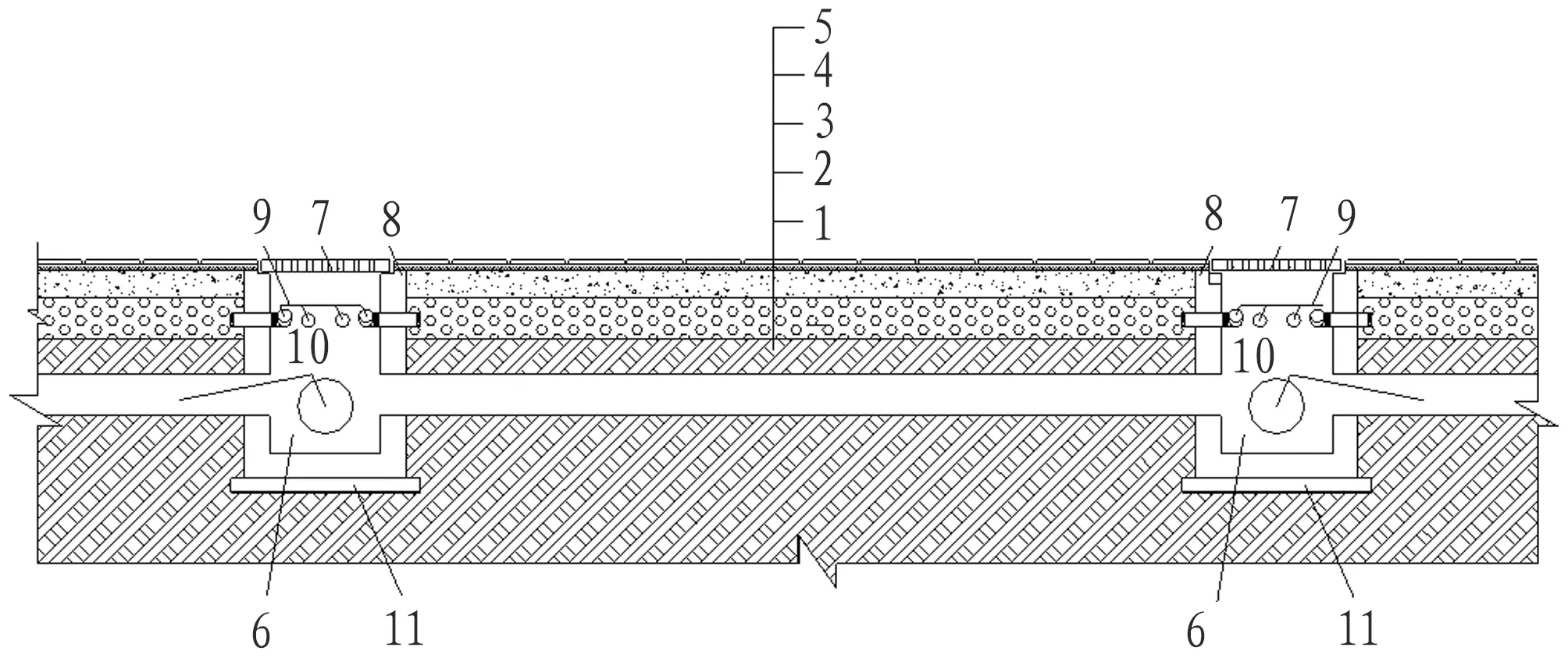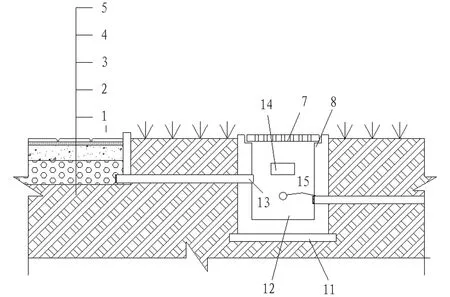Research and Application of Ecological Outdoor Ground Structure with Composite Water Storage and Drainage Function
2023-10-28PengZHONGYuqiFANZhenggenFAN
Peng ZHONG, Yuqi FAN, Zhenggen FAN
College of City Construction, Jiangxi Normal University, Nanchang 330022, China
Abstract In order to solve the problems of surface runoff increase, water accumulation in rainy days and urban heat island effect, an ecological outdoor ground structure with composite water storage and drainage functions was studied and applied in this paper. Through the comprehensive design of road ground, road inspection well, garden inspection well and drainage pipe network, it can quickly store and drain ground water, alleviate the urban heat island effect, realize plant infiltration irrigation, and achieve the purpose of saving water and energy.
Key words Composite water storage and drainage, Waterlogging prevention, Ecological type, Outdoor ground
1 Introduction
In the context of urbanization development and global climate change, the problem of urban flood disaster in China is becoming more and more serious[1]. During the period of heavy rainfall, the urban drainage system can not accommodate the excess surface runoff and overflow in large quantities, resulting in serious damage to urban buildings, roads, underground space and other infrastructure[2]. According to the National Bureau of Statistics, in 2020, floods occurred in 28 provinces across the country, affecting more than 70 million people cumulatively, which seriously restricted social and economic development[3]. In 2021, the "July 20" heavy rainstorm disaster in Henan Province caused 302 deaths and direct economic losses of more than 100 billion yuan, and the problem of urban flooding seriously hindered China’s social and economic development[4]. In order to achieve remarkable results in urban waterlogging control, the 14thFive-Year Plan in 2021 proposed to build an urban flood control and drainage system with the functions of source emission reduction and combination of storage and drainage. Therefore, how to improve the urban drainage facilities, improve the drainage network, and construct the flood control and drainage system has important practical significance and practical value to promote the urban waterlogging control and sustainable development.
Urban waterlogging refers to the phenomenon of urban waterlogging disasters caused by heavy rainfall or continuous rainfall exceeding the drainage capacity of the city. At present, many scholars focus on the construction of urban flood control and drainage system[5-11]. For example, Xie Yingxia[12]proposed a large drainage system composed of tunnels, green spaces, water systems, reservoirs, roads and other elements to solve the problem of abnormal rain. Based on the concept of ecological sponge basin construction, Wang Xiuyingetal.[13]took Pingshan River Basin in Shenzhen City as an example, and proposed a flood control and drainage structure system of "source storage and infiltration, process drainage and trapping, end drainage and diversion". Zhao Fengchangetal.[3]constructed the "3M+basin flood control" waterlogging prevention and control system, and Zhang Xiaokuietal.[14]constructed the "water advancing and people retreating" waterlogging prevention and control space system according to the waterlogging situation in the core area of Binhai New Town in Fuzhou. Although the existing urban flood control and drainage system has played a certain role in improving the urban drainage system, it only emphasizes the discharge of waterlogging water in the system construction, and does not take into account the improvement of the existing drainage system, at the same time, the focus of improvement should turn to the combination of outdoor rainwater storage and infiltration and green use.
In view of this, we studied the formation mechanism of urban waterlogging, analyzed the design connotation of permeable ground and urban drainage system, provided a design idea and practice of ecological outdoor ground with composite water storage and drainage function, made clear the existing difficulties and propose solutions, and evaluated the implementation mode and effect of ecological ground with composite water storage and drainage. The proposed structure has the advantages of simple structure, convenient construction, flexible use and low cost. It can not only promote urban waterlogging management, but also play a role in saving water and energy, alleviating the urban heat island effect and reducing noise and dust, so as to provide a reference for future research.
2 Difficult problems
2.1 Rapid drainage of surface pondingUrban waterlogging has become one of the important problems in the urban development of China, which not only causes serious economic losses and casualties, but also reflects the "big city disease". How to solve the problem of rapid drainage of urban surface water in a natural way is an important part of improving the urban drainage system. In most cities in China, the flood control and drainage system is mainly composed of inspection wells, drainage pipe network and internal rivers. Surface rainwater mainly enters inspection wells and drainage pipelines through the ground of municipal roads and then is discharged from urban internal rivers. If the outdoor ground materials such as leisure squares, sidewalks, landscape walkways and light roadways are made of impermeable materials, the surface runoff will be prevented from seeping into the soil, resulting in the increase of surface runoff and the shortening of flood peak formation time under the same rainfall conditions, thus increasing the pressure of urban flood control. However, with the passage of time, drainage pipelines are prone to local blockage, which reduces drainage capacity, resulting in surface water accumulation in rainstorm weather can not be removed in time, affecting the normal passing of residents and vehicles. If we change the single centralized drainage mode of inspection wells, strengthen the function of urban surface drainage, and construct a composite drainage mode of point-plane combination and integration of ground and underground, we can quickly remove surface water accumulation in rainstorm weather and effectively alleviate the disaster caused by surface water accumulation in rainy days. However, it is a difficult problem of how to select the ground material, design the ground structure and drainage system, and realize the composite drainage function of the ground, inspection well and underground pipe network.
2.2 Ecological utilization of underground water storageThe total amount of freshwater resources in China is 2.8 trillion m3, ranking sixth in the world, but the per capita freshwater resources account for about 1/4 of the world per capita level. As a country with a large population, China has a huge demand for freshwater resources. Although the annual average amount of rainwater exceeds 6 trillion m3, most of the rainwater is lost, and the utilization rate of rainwater is less than 1%[15]. Improving the efficiency of rainwater use is conducive to alleviating the pressure of freshwater shortage in China. With the continuous expansion of urban scale, the soil covered with vegetation is gradually replaced by the tar concrete road. Because cement, asphalt and other materials have small reflectivity, fast heat conduction, small specific heat capacity and other properties, under the same solar radiation conditions, compared with the natural soil ground, they absorb more heat and evaporate less heat, resulting in heat island effect. At present, the main measure to solve this problem is to sprinkle water on the road surface regularly with sprinklers to cool the ground from top to bottom. If the ground rainwater can be collected and treated properly, it can not only reduce the burden of urban drainage system, but also apply rainwater to the ground cooling and irrigation of flowers, plants and trees around the road to meet the objective water demand of plants, produce certain economic benefits, and meet the sustainable development of China. It will help to improve China’s water shortage. How to realize the efficient use of water resources under the premise of low water consumption and low economic cost, and how to develop and utilize the rainwater collected by the water storage function of the surface channel to cool the ground and irrigate the garden green space, is also a difficult problem that must be solved.
3 Solutions
The ecological outdoor ground structure with composite water storage and drainage function described in this study is shown in Fig.1, which is composed of outdoor roads, outdoor green space, road inspection wells, garden inspection wells and other parts. The ground of the outdoor road is a permeable ground, the outdoor green space is a roadside green space, the road inspection well and the garden inspection well are separately arranged in the outdoor road and the roadside green space, and the top of each inspection well is provided with a well cover with a hole for draining accumulated water; the well wall of the road inspection well is connected with a drainage pipe I and a drainage pipe II, the garden inspection well is connected with a water inlet pipe, an overflow pipe and a seepage pipe, and the overflow pipe is linked with a municipal pipeline. The permeable layer, the inspection well and the underground pipe network work together to effectively realize the functions of composite drainage, water storage and infiltration irrigation in the soil. The specific methods of each part are as follows.

Note: 1. compacted soil layer; 2. permeable base layer; 3. cast-in-situ permeable layer; 4. permeable paving layer; 5. permeable brick layer; 6. road inspection well; 7. inspection well top cover; 8. well wall; 9. drainage pipe I; 10. drainage pipe II; 11. cushion layer.

Note: 1. compacted soil layer; 2. permeable base layer; 3. cast-in-situ permeable layer; 4. permeable paving layer; 5. permeable brick layer; 11. cushion layer; 12. garden inspection well; 13. water inlet pipe; 14. overflow pipe; 15. seepage pipe.
3.1 Structure of road groundThe outdoor road consists of a compacted soil layer 1, a permeable base layer 2, acast-in-situpermeable layer 3, a permeable paving layer 4 and a permeable brick layer 5 from bottom to top. The permeable base shall be a crushed stone layer with a thickness of 150-250 mm and a porosity of 20%-40%. Thecast-in-situpermeable layer is made of permeable concrete with a thickness of 100-200 mm, and the continuous porosity is 15%-25%. In order to prevent the ground from cracking due to the change in outdoor temperature difference, the vertical and horizontal temperature joint spacing of the permeable concrete layer is 4 000-6 000 mm. When the outdoor ground is a vehicle driving ground, the permeable brick layer 5 and the permeable paving layer 4 are not paved. When the outdoor ground is a pedestrian ground, such as a sidewalk, a landscape walkway, a small leisure square and the like, the permeable brick layer 5 and the permeable paving layer 4 can be paved to improve the artistry and the beauty of the ground. The road inspection well 6, the first drainage pipe 9 and the second drainage pipe 10 are arranged in the outdoor road, so that the composite drainage and water storage functions of the ground can be realized.
3.2 Structure of road inspection wellThe road inspection wells 6 are distributed in the outdoor road ground to collect and remove surface ponding. The road inspection well 6 is sequentially provided with an inspection well top cover 7, a well wall 8, a first drainage pipe 9, a second drainage pipe 10 and a cushion layer 11 from top to bottom. One end of each drain pipe 9 is uniformly distributed on the well wall 8 of the road inspection well 6 and is connected with a rotary elbow, the other end of each drain pipe 9 is connected with the permeable base layer 2, and the rotary elbow can rotate around the drain pipes 9 to adjust the water storage height of the permeable base layer. The first drainage pipes 9 are on the same horizontal plane, and the vertical distance between the bottom and the bottom of the permeable base layer 2 is 50 mm. One end of the first drain pipes 9 connected with the water permeable base layer 2 is provided with a grid-shaped filter cover. The shaft wall 8 of the road inspection shaft shall be built with clay bricks or poured with concrete, the concrete strength grade shall not be lower than C20, and the bottom cushion 11 shall be poured with C10 concrete.
3.3 Structure of garden inspection wellThe garden inspection well 12 is arranged in the roadside greenbelt, and is provided with an inspection well top cover 7, a well wall 8, a water inlet pipe 13, an overflow pipe 14, a water seepage pipe 15 and a cushion layer 11 from top to bottom in sequence. The water inlet pipe 13 is connected with one end of the permeable base layer 2 and is provided with a grid-shaped filter cover; the overflow pipe 14 is connected with a municipal drainage pipe and can drain rainwater flowing in from the top cover 7 of the garden inspection well in rainy days to the municipal drainage pipe. The outer surface of the seepage pipe 15 is provided with many fine holes, and the periphery of the seepage pipe 15 is provided with a gravel filter layer to prevent silt from blocking the fine holes on the seepage pipe 15. The top of the inlet pipe 13 is lower than the bottom of the overflow pipe 14, and the bottom of the inlet pipe 13 is higher than the top of the seepage pipe 15. The shaft wall 8 of the garden inspection shaft is built with clay bricks or poured with concrete, the concrete strength grade is not lower than C20, and the bottom cushion 11 is poured with C10 concrete.
4 Implementation method
With reference to Fig.1 and 2, we further explain a specific implementation case of the proposed ground. When in use, user rotates the rotary elbow on the first drain pipe 9 to adjust the water level in the permeable base layer 2. When it rains, rainwater will flow into the road inspection well 6 and the garden inspection well 12 through the top cover 7 of the road inspection well and the garden inspection well. The rainwater on the ground of the outdoor road can also flow into the permeable base layer 2 through the permeable brick layer 5, the permeable paving layer 4 and the cast-in-place permeable layer 3. After storing a part of rainwater in the permeable base layer 2, the excess rainwater can be discharged into the road inspection well 6 and the garden inspection well 12, and then discharged into the municipal drainage pipe separately through the second drainage pipe 10 and the overflow pipe 14, so as to realize the composite water storage and drainage function. The water in the permeable base layer 2 and the garden inspection well 12 carries out seepage irrigation on flowers, plants and trees in the green space through the seepage pipe 15. When the rain stops, the rainwater in the permeable base layer 2 evaporates into the air, which can adjust the air temperature and humidity, alleviate the urban heat island effect and realize the ecological application of underground water storage.
5 Implementation effect
5.1 Theoretical calculationAccording to the average thickness of the ground permeable base of 200 mm, the porosity is 30%. The average thickness of thecast-in-situpermeable layer is 150 mm, the porosity is 20%, and the average storage capacity per unit area of the outdoor ground is 0.09 m3, which is converted into 90 mm of precipitation. According to the meteorological data, according to the 12-h rainfall standard (mm), light rain<5 mm, moderate rain 5.0-14.9 mm, heavy rain 15.0-29.9 mm, torrential rain 30.0-69.9 mm, downpour 70.0-139.9 mm, and heavy downpour>140 mm. Therefore, without considering the soil seepage and rainwater flowing into the road inspection well 6, only the water storage capacity of the ground permeable base (gravel) and thecast-in-situpermeable layer (permeable concrete) can achieve 12 h of torrential rain without water accumulation. Considering that 40% of the ground rainwater flows into the municipal drainage pipeline, there is no water on the ground surface in 12 h of downpour weather.
5.2 Project applicationThis ground practice has been put into use in the construction project of a construction group since May 2021. According to the general layout plan of the temporary facilities of the project, the effective collection area was about 1 000 m2, and the total annual catchment was about 1 471.5 m3. Through the further research and development of the composite water storage and drainage environmental protection ground and the realization of a series of derivative systems in the project, such as the temporary fire fighting system based on the rainwater recycling system, the main structure and tower crane spray dust suppression system, the construction site green space spray irrigation system. These systems have become a favorable guarantee for the company’s project to create a safe and civilized model site in the province, promote green construction in the ten new technologies of the construction industry, and establish a good corporate image in the local and owners.
6 Conclusions
The construction of urban flood control and drainage system with the function of combining storage and drainage is the requirement of China’s "14thFive-Year Plan" to solve the problem of urban drainage and waterlogging prevention. The prevention and control of urban waterlogging should be carried out on the basis of system integration and improvement of drainage system, so as to eliminate the hazards caused by rainwater and flood as far as possible, and turn them into resources for human use. The ecological outdoor ground designed in this study can not only promote urban drainage, but also effectively store rainwater for road green space irrigation. It has the functions of promoting urban waterlogging management, saving water and energy, alleviating urban heat island effect and green irrigation, and has high economic and social effects.
杂志排行
Asian Agricultural Research的其它文章
- Solid Material Formula of Small Fragrant Chicken Soup Stock and Improvement of Boiling Process
- Extraction Conditions of Essential Oil from Eucalyptus Leaves by Distillation
- Bioinformatics Analysis of Q0D1P0 Gene of Mangrove Endophytic Fungus Aspergillus terreus
- Planting Adaptability of Four Kinds of Common Vegetables in Shanghai
- Problems and Countermeasures of Fruit and Vegetable Logistics Distribution Development in Guangxi Zhuang Autonomous Region
- Evaluation and Exploration of Citrus Germplasm Resources in the Origin of Shatangju (Citrus flamea Hort.ex Tseng Shiyueju)
